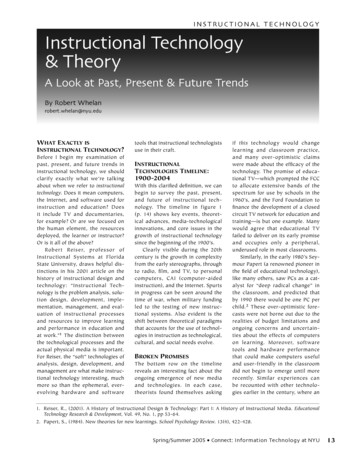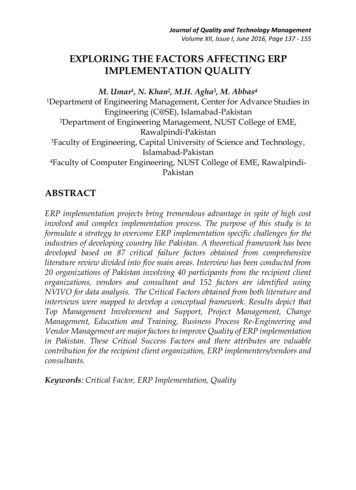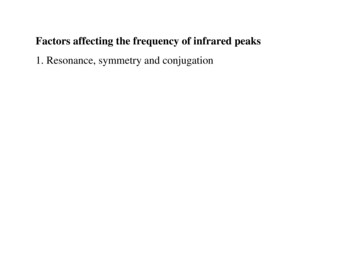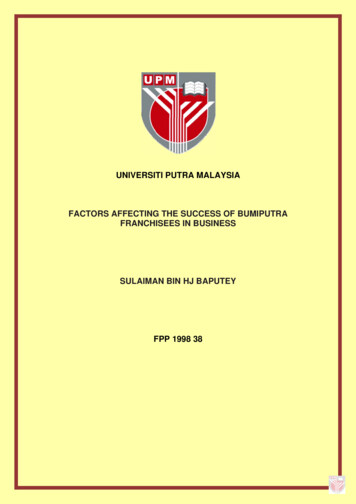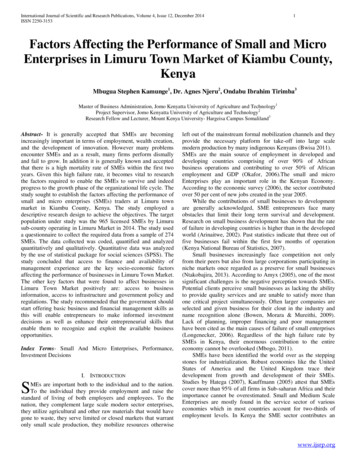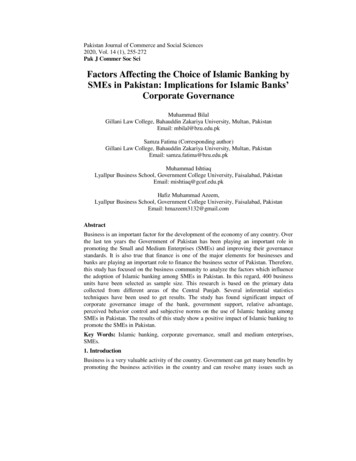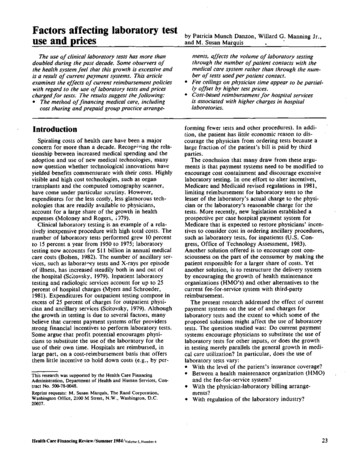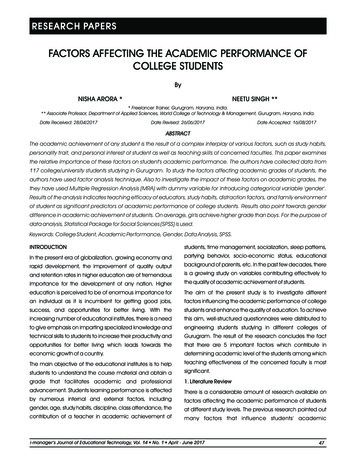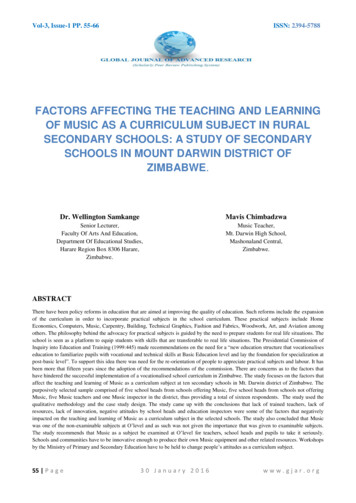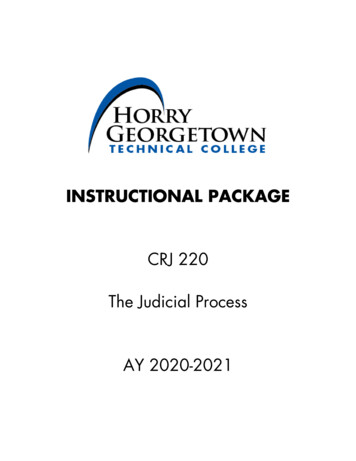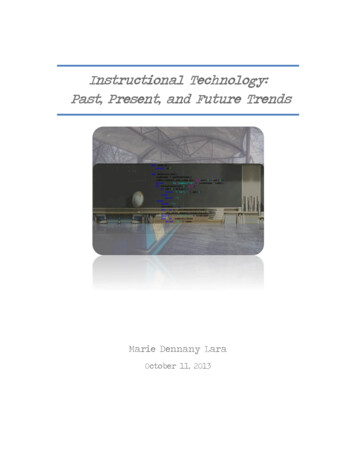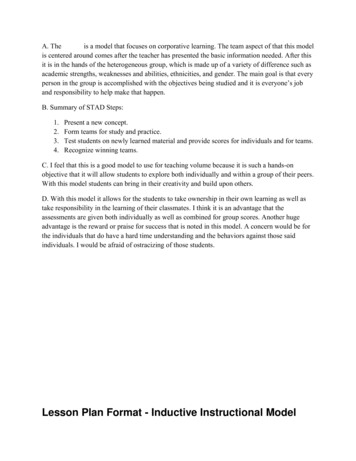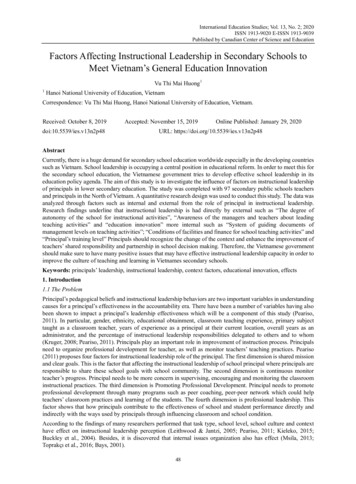
Transcription
International Education Studies; Vol. 13, No. 2; 2020ISSN 1913-9020 E-ISSN 1913-9039Published by Canadian Center of Science and EducationFactors Affecting Instructional Leadership in Secondary Schools toMeet Vietnam’s General Education InnovationVu Thi Mai Huong11Hanoi National University of Education, VietnamCorrespondence: Vu Thi Mai Huong, Hanoi National University of Education, Vietnam.Received: October 8, 2019doi:10.5539/ies.v13n2p48Accepted: November 15, 2019Online Published: January 29, 2020URL: tly, there is a huge demand for secondary school education worldwide especially in the developing countriessuch as Vietnam. School leadership is occupying a central position in educational reform. In order to meet this forthe secondary school education, the Vietnamese government tries to develop effective school leadership in itseducation policy agenda. The aim of this study is to investigate the influence of factors on instructional leadershipof principals in lower secondary education. The study was completed with 97 secondary public schools teachersand principals in the North of Vietnam. A quantitative research design was used to conduct this study. The data wasanalyzed through factors such as internal and external from the role of principal in instructional leadership.Research findings underline that instructional leadership is had directly by external such as “The degree ofautonomy of the school for instructional activities”, “Awareness of the managers and teachers about leadingteaching activities” and “education innovation” more internal such as “System of guiding documents ofmanagement levels on teaching activities”; “Conditions of facilities and finance for school teaching activities” and“Principal’s training level” Principals should recognize the change of the context and enhance the improvement ofteachers’ shared responsibility and partnership in school decision making. Therefore, the Vietnamese governmentshould make sure to have many positive issues that may have effective instructional leadership capacity in order toimprove the culture of teaching and learning in Vietnames secondary schools.Keywords: principals’ leadership, instructional leadership, context factors, educational innovation, effects1. Introduction1.1 The ProblemPrincipal’s pedagogical beliefs and instructional leadership behaviors are two important variables in understandingcauses for a principal’s effectiveness in the accountability era. There have been a number of variables having alsobeen shown to impact a principal’s leadership effectiveness which will be a component of this study (Peariso,2011). In particular, gender, ethnicity, educational obtainment, classroom teaching experience, primary subjecttaught as a classroom teacher, years of experience as a principal at their current location, overall years as anadministrator, and the percentage of instructional leadership responsibilities delegated to others and to whom(Kruger, 2008; Peariso, 2011). Principals play an important role in improvement of instruction process. Principalsneed to organize professional development for teacher, as well as monitor teachers’ teaching practices. Peariso(2011) proposes four factors for instructional leadership role of the principal. The first dimension is shared missionand clear goals. This is the factor that affecting the instructional leadership of school principal where principals areresponsible to share these school goals with school community. The second dimension is continuous monitorteacher’s progress. Principal needs to be more concern in supervising, encouraging and monitoring the classroominstructional practices. The third dimension is Promoting Professional Development. Principal needs to promoteprofessional development through many programs such as peer coaching, peer-peer network which could helpteachers’ classroom practices and learning of the students. The fourth dimension is professional leadership. Thisfactor shows that how principals contribute to the effectiveness of school and student performance directly andindirectly with the ways used by principals through influencing classroom and school condition.According to the findings of many researchers performed that task type, school level, school culture and contexthave effect on instructional leadership perception (Leithwood & Jantzi, 2005; Peariso, 2011; Kieleko, 2015;Buckley et al., 2004). Besides, it is discovered that internal issues organization also has effect (Msila, 2013;Toprakçı et al., 2016; Bays, 2001).48
ies.ccsenet.orgInternational Education StudiesVol. 13, No. 2; 2020There has been some classification of instructional leadership skills of school principals in the related literature.These classifications mainly consist of identifying and defining the school visions, missions and goals, buildingconsensus about school goals, providing the necessary resources for teaching, coordination, management, controland evaluation of teaching and curriculum, monitoring evaluating and developing the staff, creating closerelationship and cooperation between staff, regular teaching-learning climate, enabling the support from societyand environment, being a role model and teaching source (Baker & Cooper, 2005; Hallinger, 2005; Fernandez etal., 2007; Williams et al., 2005; Botha, 2004; Bays, 2001; Issa, 2012).Principal is the most important person, not only to take care of any problems but also for achieving school’s goalsand objectives. Principal’s role for the school is endless; among all the most important is instructional leadership.There are many factors affecting instructional leadership. They are internal factors that belong to the principalssuch as gender, competence, awareness. There are factors that belong to the external context. However, thesefactors are being evaluated separately in many different studies. Vietnam has been implementing radical educationinnovation from content-based education to competence-based education approach since 2018, the instructionalleadership of principals has been strongly influenced by the enormous impact of context, facilities, capacity andtraining level, ability to adapt to change of principal. The researches on that issue have been limited.1.2 Literature Review1) Leadership in teachingThe concept of instructional leadership has been extensively studied in the 1980s and 1990s (Hallinger, 2000,2003). There are many models and concepts that exist to explain instructional leadership. Among models andguiding leadership theory can be called Model Hallinger and Murphy (1985), Weber (1996) Model, Murphy(1990) Model, and McEwan (2009) Model. Hallinger and Murphy (1985) defined instructional leadership as theprincipal’s behavior to promote and improve the teaching and learning process in schools related to teachers,students, parents, school plans, and management–management of schools, facilities and schools. Hallinger (2013)has developed the Key Guidance Evaluation Tool (PIMRS) that has been applied in more than 175 surveysworldwide.Hallinger (2009, p. 1) views instructional leadership by school leaders as a relatively new concept that emerged inthe 1980s, which called for a shift in emphasis from principals as managers or administrators to instructional oracademic leaders. Hallinger (2009, p. 2), in his analysis of instructional leadership, administration, andmanagement, argues that instructional leadership involves: setting clear goals; allocating resources for instruction;managing the curriculum; monitoring lesson plans; and evaluating teachers. It also involves those actions that theprincipal performs or delegates to others to promote growth in student learning. Some of the key elements thatcharacterize instructional leadership and distinguish it from management and administration include prioritization;a focus on alignment of the curriculum, instruction and assessment standards; data analysis; a culture of continuouslearning for adults; school culture and climate; visionary instructional leadership; and the variables related toinstructional leadership.The role of school leaders is not only to manage the school but also functions as instructional leaders. Theeffectiveness of the school depends on the school leader’s instructional leadership. This study focuses on the firstdimension of the instructional leadership conceptual framework. Defining a school mission is the first dimensionof the framework that identifies how the school leaders practicing instructional leadership to define the school’sgoals (Rashdi & Khamis, 2017).Through constructivist learning theory instructional leader can use the principles in the theory to improve theclassroom instruction and create clear academic goals. There are principles for effective teaching and learning; 1)to make connections with the student’s existing knowledge structure, teaching must begin with a content andfamiliar experiences, 2) the knowledge given should not change the students cognitive model too extreme ordrastic, 3) the teaching aimed is to empower the students with skill to be independent, and be able to use relevantinformation from various sources to solve the problems and challenges, and 4) the learning activities more tocooperative learning that involve with the students working in small groups and discussing to find the answer(Makgato, 2012).School principals are expected to play a pivotal role in enhancing quality teaching and learning in their schools.The role of school leaders is not only to manage the school but also functions as instructional leaders. Theeffectiveness of the school depends on the school leader’s instructional leadership. Alig-Mielcarek (2003)determined that instructional leadership focus on defining and communicating shared goals: meaning that theleader is responsible to establish collaboratively with staff what goals they are aspiring to attain and how they willcollectively and individually achieve the outcomes for which they are striving; Monitoring and providing feedback49
ies.ccsenet.orgInternational Education StudiesVol. 13, No. 2; 2020on the teaching and learning process: the leader should be present to the teachers and students. The instructionalleader is visible around the school, constantly communicating with everyone about standards and achievements;promoting school-wide professional development: there should be a culture of learning at all levels in theinstitution. Instructional leaders provide opportunities for professional development as well as data collection forimproved instruction and student achievement.2) Factors affecting teaching leadershipConsidering academic achievement in terms of factors affecting instructional leadership of school principalperformance is generally based on two components. The first of these is the competences of the school principaland external factor from teacher, staff, school environment, educational policy, and educational reform. Ozdemir(2019) conducted to examine the effect of the principal relating to instruction. This includes statements onidentifying school goals; knowing the teacher expectations; deciding on institutional goals in conjunction withstudents, teachers and parents; and creating family expectations about enabling students to reach these goals. Msila(2013), Toprakçı et al. (2016), and Bays (2001) focus on teacher and staff in each school. A supportiveenvironment plays an importance part in instructional leadership (Leithwood & Jantzi, 2005; Peariso, 2011;Kieleko, 2015; Buckley et al., 2004).3) The training level, leadership capacity of the principalThe principal must be a leader, giving the right plans to develop the school in a positive direction. In theinstructional leadership process, the principal of the principal is the skill of developing goals, planning, programdevelopment, communication capacity, sharing and cooperation, and motivational capacity to encourage creativityand innovation. Related to the personnel is the skill of assignment in accordance with each nature of the job toachieve high efficiency. The leadership capacity of a principal is very important to the teaching activities of theschool and also motivates the learning activities and teaching and development activities. The capacity,qualifications and capacity of leaders and principals have a direct impact on the results of teaching activities.Therefore, the school always pays attention to fostering professional capacity for management staff.Wieczorek and Manard (2018) express that the principals focused heavily on developing relationships and trustamong their teachers, students, and parents. Effective instructional leaders play an important role in creating andencouraging instructional development in school; many researchers employ varying terminology in building theprofiles of effective leaders, such as skills, competencies, descriptors, dimensions, and capabilities. We willsummarize the concepts as though they are synonymous terms, in that they all present observable, assessable, andeven potentially measurable qualities of a school leader (Hallinger, 2005; Research and Innovation for StudentLearning, 2018)Baker and Cooper (2005) found that principals with strong academic backgrounds were 3.3 times more likely torecruit, select, and retain teachers with similar academic attributes. Baker and Cooper (2005) suggested this isimportant since the literature from economic and educational policy research indicates that teachers with strongacademic backgrounds produce better student outcomes. Fernandez et al. (2007) also found that a principal’seducational attainment had a significant influence on their school’s standardized test scores and student attendancerates. The backgrounds of educational leaders as classroom teachers have also shown to affect leadershipoutcomes. Williams et al. (2005) found that principals’ years of experience correlate with high studentachievement.Botha (2004) argues that theoretical knowledge is as important as tacit and experiential knowledge. Theknowledge of practice and educational theories puts principals in a better position to know the challenges teachersface when they are implementing the curriculum. The principal as the instructional leaders must be well-informedabout current developments in the education sector since the instructional context is forever changing.Bays (2001) pointed out that principals of schools whose enrolment is high have a lot of issues to addresscompared to principals who have lower enrolments. Principals of high enrolment schools are therefore confrontedwith many competing administrative and managerial responsibilities which reduce the time available to theprincipal for direct interaction with teachers on instruction matters.According to Issa (2012) and Kieleko (2015), teaching load of the principal influences the effectiveness of theprincipals’ instructional supervision. There are three basic skills of supervision–technical, human and conceptual.Each of these skills domains applies to educational and organizational roles of supervisors as well. Technical skillsassume ability to use knowledge, methods to perform specific tasks. Human skills refer to one’ ability andjudgment in working with and through people. Conceptual skills refer to the supervisor’s ability to view theschools and the educational program as a whole. Supervision requires Planning, Staffing, Coordination,50
ies.ccsenet.orgInternational Education StudiesVol. 13, No. 2; 2020Observation, Curriculum development and Assessment. Findings revealed that principals’ supervisorycompetency was found to be significantly influenced by their administrative experiences (Sergiovanni, 2009;Kieleko, 2015).4) Awareness of managers and teachers on leadership of teaching activitiesPrincipals are often perceived to be associated with a manager’s job rather than a leader’s job. In fact, theprincipal’s job is also the leadership of activities in general, leading teaching activities in particular. Currently, inVietnam, the concept of teaching leadership is relatively new. Therefore, the principal’s awareness and the teachersin the schools will directly affect the effectiveness of the teaching leader. When carrying out activities related toteaching leadership, the principal himself must become an expert in teaching activities in the school; is a bridgebetween the parties involved in the school’s teaching activities. If the ability to connect, motivate and encouragecreative sharing is confirmed, teachers and students will have many advantages in teaching and learning. Theeffectiveness of teaching is affirmed as a core channel to attract stakeholders to create resources for thedevelopment of the school. In addition, the school’s teachers and staff, when they are good at teaching, grasp themission, the school’s second-hand will develop themselves more and more perfect, because the school is acollective each staff, teacher, and staff in the school is an individual. If you want a team to develop, each individualmust develop and then grow together. Requires each teacher and manager to clearly identify and recognize theimportance of teaching issues to the reputation and effectiveness of the school (Msila, 2013).Teachers are given opportunities for professional development in order to gain effective skills for curriculumcoverage. The schools make sure that the curriculum is covered so that the students have the opportunity to meetthe contents of the national examinations. The schools ensure the existence of the strong cordial relationships withthe parents in order to complete each other on the addressing the expectations of the students. Teachers as well asthe students are recognized for their achievements in order to motivate them (Toprakçı et al., 2016).Bays (2001) expressed that a large number of teachers and high student enrolment is associated with emphasis onbureaucratic approach since the high span of control denies the principal enough time for individualized attentionupon teachers. A small number of teachers and students mean a narrower span of control giving principals anopportunity to interact regularly with teachers during supervision hence collaboration5) School culture actively encourages sharing, cooperation and innovationIn the traditional management model, the school manager perceives the school’s goal to be clear, simple and highlystable, hence the concept of nature, the school is only a tool and methods to accomplish existing goals; In schoolteachers like a hired employee whose value is like a tool, if appropriate, will be used. Currently there are majorchanges in the concept of organization, which is where people live and develop, not just a tool to achieve theintended goal. The school organization is associated with the leader of teaching activities, not only is theworkplace preparing for the future but also the place for students and teachers, the staff to grow and develop more.If the education environment is not friendly, it is difficult to prepare for the future of students as well asprofessional development, professional enthusiasm in teachers and school officials and employees. Thedevelopment of a school-based staff will determine the school’s performance. Study leaders emphasize sharingand cooperation, emphasizing motivation and encouraging innovation and creativity, thus building a culture thatencourages innovation and collaboration will help improve efficiency, teaching and learning activities.Sharm (2012) in the latest findings accounted for instructional leadership of the participant principals as leadershipfor overall development of students, supported commitment for overall development of students, shared decisionmaking, involving supervisory models and continuous professional development. It also advocated the benefits ofinstructional leadership in terms of fulfillment of higher needs of recognition, self-esteem and self-actualization ofstudents, teachers and th
worldwide. Hallinger (2009, p. 1) views instructional leadership by school leaders as a relatively new concept that emerged in . The training level, leadership capacity of the principal The principal must be a leader, giving the right pl
